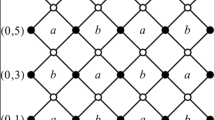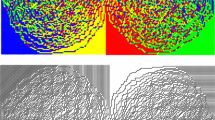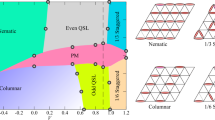Abstract
In Bain (J Math Phys 64(2):023301, 2023. https://doi.org/10.1063/5.0097256), we found asymptotics of one-point correlation functions of the two-periodic weighted Aztec diamond in the mesoscopic limit, where the linear size of the ordered region is of the same order as the correlation length. In this paper, we follow up with a numerical study of two-point correlation functions of dimers separated by a mesoscopic distance.








Similar content being viewed by others
Availability of data and materials
Data sharing is not applicable to this article as no datasets were generated or analyzed during the current study.
References
Bain, E.: Local correlation functions of the two-periodic weighted Aztec diamond in mesoscopic limit. J. Math. Phys. 64(2), 023301 (2023). https://doi.org/10.1063/5.0097256
Thurston, W.P.: Conway’s tiling groups. Am. Math. Mon. 97(8), 757–773 (1990). https://doi.org/10.1080/00029890.1990.11995660
Cohn, H., Kenyon, R., Propp, J.: A variational principle for domino tilings. J. Am. Math. Soc. 14(2), 297–346 (2000). https://doi.org/10.1090/s0894-0347-00-00355-6
Kenyon, R., Okounkov, A.: Limit shapes and the complex burgers equation. Acta Math. 199(2), 263–302 (2007)
Astala, K., Duse, E., Prause, I., Zhong, X.: Dimer models and conformal structures. arXiv: Analysis of PDEs (2020)
Elkies, N., Kuperberg, G., Larsen, M., Propp, J.: Alternating sign matrices and domino tilings I. J. Algebr. Combin. 1, 111–132 (1992)
Elkies, N., Kuperberg, G., Larsen, M., Propp, J.: Alternating sign matrices and domino tilings II. J. Algebr. Combin. 1, 219–234 (1992)
Chhita, S., Young, B.: Coupling functions for domino tilings of Aztec diamonds. Adv. Math. 259, 173–251 (2014). https://doi.org/10.1016/j.aim.2014.01.023
Francesco, P.D., Soto-Garrido, R.: Arctic curves of the octahedron equation. J. Phys. A Math. Theor. 47(28), 285204 (2014). https://doi.org/10.1088/1751-8113/47/28/285204
Johansson, K.: The arctic circle boundary and the Airy process. Ann. Probab. 33(1), 1–30 (2005). https://doi.org/10.1214/009117904000000937
Chhita, S., Johansson, K.: Domino statistics of the two-periodic Aztec diamond. Adv. Math. 294, 37–149 (2016)
Duits, M., Kuijlaars, A.B.J.: The two periodic Aztec diamond and matrix valued orthogonal polynomials. J. Eur. Math. Soc. (JEMS) 23(4), 1075–1131 (2021)
Berggren, T., Duits, M.: Correlation functions for determinantal processes defined by infinite block toeplitz minors. Adv. Math. 356, 106766 (2019). https://doi.org/10.1016/j.aim.2019.106766
Johansson, K.: Edge fluctuations of limit shapes. Curr. Dev. Math. 2016, 47–110 (2017)
Beffara, V., Chhita, S., Johansson, K.: Airy point process at the liquid-gas boundary. Ann. Probab. 46(5), 2973–3013 (2018)
Beffara, V., Chhita, S., Johansson, K.: Local geometry of the rough-smooth interface in the two-periodic Aztec diamond. Ann. Appl. Probab. 32(2), 974–1017 (2022)
Johansson, K., Mason, S.: Dimer-dimer correlations at the rough-smooth boundary. Commun. Math. Phys. (2023). https://doi.org/10.1007/s00220-023-04649-1
Johansson, K., Mason, S.: Airy process at a thin rough region between frozen and smooth. arXiv (2023). https://doi.org/10.48550/ARXIV.2302.04663 . https://arxiv.org/abs/2302.04663
Belov, P.A., Reshetikhin, N.: The two-point correlation function in the six-vertex model. J. Phys. A Math. Theor. 55, 155001 (2022)
Kenyon, R., Okounkov, A., Sheffield, S.: Dimers and amoebae. Ann. Math. 163(3), 1019–1056 (2006). https://doi.org/10.4007/annals.2006.163.1019
Kenyon, R.: Local statistics of lattice dimers. Ann. Inst. Henri Poincare (B) Probab. Stat. 33(5), 591–618 (1997). https://doi.org/10.1016/s0246-0203(97)80106-9
Mason, S.: Two-periodic weighted dominos and the sine-Gordon field at the free fermion point: I. arXiv (2022). https://doi.org/10.48550/ARXIV.2209.11111 . https://arxiv.org/abs/2209.11111
Keating, D., Sridhar, A.: GitHub (2018). https://github.com/GPUTilings
Keating, D., Sridhar, A.: Random tilings with the GPU. J. Math. Phys. 59(9), 091420 (2018). https://doi.org/10.1063/1.5038732
Acknowledgements
This research was partly supported by NSF Grant DMS-1902226. We are grateful to Nicolai Reshetikhin for guidance during the course of this work. We used code based on the source code developed by Keating and Sridhar [23] to simulate domino tilings. We thank Scott Mason for correspondence which resulted in a simplification of the paper. We are grateful to the Yau Mathematical Sciences Center, Tsinghua University, where much of this work was completed. This research used the Savio computational cluster resource provided by the Berkeley Research Computing program at the University of California, Berkeley (supported by the UC Berkeley Chancellor, Vice Chancellor for Research, and Chief Information Officer).
Author information
Authors and Affiliations
Corresponding author
Ethics declarations
Conflict of interest
The authors have no relevant financial or non-financial interests to disclose.
Additional information
Publisher's Note
Springer Nature remains neutral with regard to jurisdictional claims in published maps and institutional affiliations.
Appendix A Definition of \({\mathcal {I}}^{j,k}_{{\varepsilon _1},{\varepsilon _2}} (a, x_1, x_2, y_1, y_2)\)
Appendix A Definition of \({\mathcal {I}}^{j,k}_{{\varepsilon _1},{\varepsilon _2}} (a, x_1, x_2, y_1, y_2)\)
Let
For \(\omega \in {\mathbb {C}}\setminus i[-\sqrt{2c},\sqrt{2c}]\) we define
where the square roots on the right hand side are the principal branch of the square root. Define
For even \(x_1, x_2\) with \(0< x_1,x_2 < 2n\) define
For \(j,k,{\varepsilon _1},{\varepsilon _2} \in \{0,1\}\), define
where the functions \(Q_{\gamma _1,\gamma _2}^{{\varepsilon _1},{\varepsilon _2}}(\omega _1,\omega _2)\) are defined as follows. Let
Now we define the following rational functions. We temporarily consider weights a and b where b is not necessarily 1. Let
For \(\gamma _1,\gamma _2 \in \{0,1\}\) we define
When \(b=1\), we write \(\textrm{y}^{{\varepsilon _1},{\varepsilon _2}}_{\gamma _1,\gamma _2}(u,v) = \textrm{y}^{{\varepsilon _1},{\varepsilon _2}}_{\gamma _1,\gamma _2}(a,1,u,v) \). Then, define
and
where \(t(\omega )\) is defined by
For \(x = (x_1,x_2) \in \texttt{W}_{\varepsilon _1},\) and \(y = (y_1,y_2) \in \texttt{B}_{\varepsilon _2}\) with \({\varepsilon _1},{\varepsilon _2}\in \{0,1\}\), define
Let \(C_r\) denote a positively-oriented contour of radius r centered at the origin. For \(a < 1\), \(\sqrt{2c}< r < 1\) and \(x = (x_1,x_2) \in \texttt{W}_{\varepsilon _1},\, y = (y_1,y_2) \in \texttt{B}_{\varepsilon _2}\) with \({\varepsilon _1},{\varepsilon _2}\in \{0,1\}\) define
Rights and permissions
Springer Nature or its licensor (e.g. a society or other partner) holds exclusive rights to this article under a publishing agreement with the author(s) or other rightsholder(s); author self-archiving of the accepted manuscript version of this article is solely governed by the terms of such publishing agreement and applicable law.
About this article
Cite this article
Bain, E. A numerical study of two-point correlation functions of the two-periodic weighted Aztec diamond in mesoscopic limit. Lett Math Phys 113, 103 (2023). https://doi.org/10.1007/s11005-023-01723-6
Received:
Revised:
Accepted:
Published:
DOI: https://doi.org/10.1007/s11005-023-01723-6




